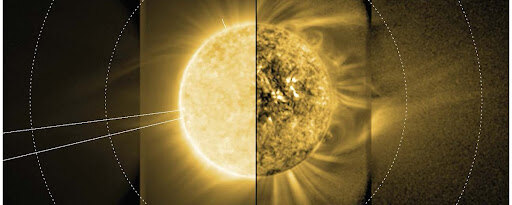Seeing the Sun in a New Light

Innovative observations of the solar corona could improve space weather forecasts

Using a NOAA telescope in a novel way, researchers from the Cooperative Institute for Research in Environmental Sciences (CIRES) working in NCEI captured the first-ever images of dynamics in the sun’s elusive middle corona. The observations, from the Solar Ultraviolet Imager (SUVI) on NOAA’s GOES-17 satellite, reveal how the middle corona influences the solar wind and eruptions from the sun, a finding that could improve space weather forecasting.
“Our instruments focus on the sun, but not at the heights needed to see these events,” says Dan Seaton, a scientist with NCEI and CIRES who led the study. “We were able to create a larger field of view and construct mosaic images of the sun showing the solar corona in extreme ultraviolet light, to answer questions about how the sun’s outer atmosphere connects to the surface of the star.”
The study, with co-authors from NASA, the Southwest Research Institute, and Lockheed-Martin, is published in Nature Astronomy.

A Novel Solar View
In August and September of 2018, the researchers captured the middle corona by using SUVI to take pictures from one side of the sun, pointing directly at the sun, and then from the other side. “We tiled the images together,” Seaton says. “It didn’t take building a new instrument, but using the instrument in a new way.”
It didn’t take building a new instrument, but using the instrument in a new way”
With the innovative technique, the researchers were able to take images of a region of the corona that is important and difficult to see. The middle corona is the place on the sun that drives the solar wind and big solar eruptions that travel to Earth and can affect various technologies here, including blocking radio communications, damaging power grids, and diminishing navigation system accuracy. “It connects to the stuff that connects to us: the middle corona is where that happens, and we haven’t observed it before,” Seaton says.
The new observations revealed surprising connections between the inner corona, with its complex magnetic structure, and the outer corona, where the solar wind flows into the heliosphere, the vast bubble of space surrounding the sun. “We didn’t think there was such a deep connection between these regions, but now we know they’re interacting all the time,” Seaton said.
The new observations revealed surprising connections between the inner corona, with its complex magnetic structure, and the outer corona, where the solar wind flows into the heliosphere”

For example, the researchers tracked material moving back and forth between regions, seeing some inflows from outside the inner corona that triggered eruptions. Farther away from the sun, more gradual outflows were observed of the kind that can influence space weather.
Boost for Space Weather Forecasts
The team’s innovation could improve how forecasters detect and track solar eruptions, such as coronal mass ejections (CMEs), that pose space weather hazards to Earth. In NOAA’s Space Weather Prediction Center, forecasters find where CMEs originate using NASA’s Large Angle Spectrometric Coronagraph (LASCO)—an instrument that blocks light from the sun and a big region around it, creating an artificial eclipse to reveal the much dimmer corona.
This approach is limited, according to Seaton, because a coronagraph misses details about what happens in the time between the first eruption and when the CME reappears farther away from the sun—details like how the CME accelerates and how much energy it gathers. That missing information affects forecast accuracy.
“With our technique, we can capture the dynamic beginnings of coronal mass ejections and see how they’re borne out into the heliosphere,” Seaton says. “That improves models of CMEs, opening the door to new science and leading to more accurate space weather forecasts.”
The team’s innovation could improve how forecasters detect and track solar eruptions, such as coronal mass ejections (CMEs), that pose space weather hazards to Earth”
Seeing the Sun in a new Light
https://www.ncei.noaa.gov/news/seeing-sun-new-light
Source: NOAA







